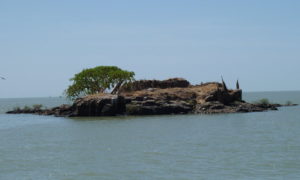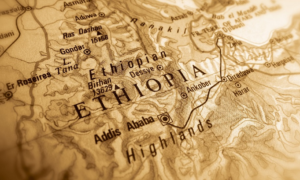Article from: The Ethiopian Herald
PHOTO ESSAY: Ethiopian Churches
First of all I should be very greatful and obliged to our “Almighty God” who blessed and given me an opportunity to work in ( his) Holy land Ethiopia, honestly speaking this was my fifth year in this home country previously. I was working for University of Gonder -Gonder, former capital of Ethiopia after the successful completion of my four years recently, I joined Mekelle University-Mekelle, Tigray State is located epicenter where abundance of Ethiopian Tourism resources are found … like; The “Historic Route” which includes, AXUM, where the history of Ethiopia as a nation may be said to have begun, the astonishing Rock Hewn Churches of LALIBELA (considered as the 8th wonder of the world). The AL NEJASHI Mosque; considered as the very first Islamic site in Africa), ADWA and some other battle fields which are extremely precious in Ethiopian history. Many Rock-Hewn, Churches dated from 4th to the 11th century are found in large numbers in Tigray, within 60-150 km from Mekelle. These are found in the clusters of Ger’alta, Tsaeda Emba, Atsbi Womberta, Tembien, Maichew and Axum. Close to Atsbi also Afar the lowest place in the planet, which has the Erte- Ale volcano, Dallol, salt lakes and the caravans.
Mekelle City particularly have also its own priceless heritage resources like Atse Yohannes Museum got splendid in its collection, Adi Haki Martyrs Monument and Museum with its rich historical thoughts of freedom, Mekelle is also surrounded by plenty of hypothetical resources for religious and cultural tourism.
Taking in to account all the Tourism source in Tigray State surrounded by Mekelle University , the Institute of Paleo Environment and Heritage Conservation established new Tourism Department begin with M.A in Tourism Development well ahead with B.A in Tourism and Hospitality Studies from the inception of Tourism Department. As a researcher the research and community and consultancy activity Initiated in the entire region by my research team.
While conducting Tourism hypothetical assessment studies in Tigrai, I had opportunities to visit some of the rock-hewn churches in the State. These opportunities, along with first hand knowledge of and scientific interest in the traditions of the region, led me to investigate the sacred place converting in to leading tourist destination. The purpose of this paper is to present a brief and general tourism account of the Ger’alta rock-hewn churches of Tigrai.
Historical overview
For many years, Ethiopia has been centre of tourism. Visitors extolled its attractions and wonders. The first illustrated travel guides to Ethiopia can be found in the friezes in the pyramids and ancient sites of Egypt. These depicted trips to the land of Punt, which the Egyptians knew was the source of the Nile, and where they traded for gold, incense, ivory and slaves. The fourth century Persian Historian Mani described the Ethiopian Kingdom of Axum as being of the four great empires of the world, ranking it alongside China, Persia and Rome. Axumite coins have been found in India and China, and the obelisks of Axum (like the one looted by Mussolini and recently returned by the Italians) are the biggest single pieces of stone erected anywhere in the world.
Ethiopia is one of the African countries that possess the highest number of United Nations Education, Social and Cultural Organization (UNESCO) World Heritage Sites in Africa, with nine sites spread throughout the whole country, four important national parks, a source of the world’s longest river, and sites revered among adherents to Christianity, Islam and Judaism and diverse African traditional societies. Ethiopia has very distinct cultural and historic products based on (a) ancient Axumite civilizations and the Ethiopian Orthodox Church; (b) the walled Old City of Harar with its seven gates considered as the fourth holiest city in Islam; (c) as a cradle of civilization, with fossilized evidence of the ancestors of homo sapiens as old as 4.4 million years B.C., and the much more famous Dinknesh, or Lucy.
Axum was believed to be an important city in the 1st Century AD and had an extensive and powerful empire, dominating the seaborne trade from Africa to Asia, with important interactions with Meroe in Nubia and Ancient Egypt. It was known to the Greeks and Romans, and features in Byzantine and Arab literature. Whilst not ancient, the religious sites of Lalibela, Bahir Dar, and Gonder date from the 16th and 17th century.
These sites are distinctly Ethiopian, and the country as a whole is without colonial influences that are a feature in other parts of Africa; in this respect Ethiopia is unique.
About Orthodox Christianity
The core of the traditional state of Ethiopia originally centered on the ancient city-state of Aksum in what is the present-day Tigrai State. Sometime between the first and third centuries a.d., King Ezana of Aksum (320-356 a.d.) occupies a vital place in Ethiopian history. Near the end of his reign the Axumite king becoming the first African king to embrace this faith and to have made Christianity the official religion of his empire.
Abyssinia maintained relatively close trading links with the Roman Empire, and this might have contributed to the adoption of Christianity a Christianity as the official religion during the middle of the fourth century.
The first Christian country in Africa Christianity is not imported from anywhere in Europe Ethiopians by birth they were Christians the Ge’ez language–the language of the church, and the orthodox Christian religion –became the vehicles through which Abyssinian culture was spread all across country and many rock-hewn churches were created.
“Ger’alta”: The rock- hewn churches
Ethiopia is one of the few places in the world where rock-hewn churches exist .Ethiopia is also a country with a long, rich, fascinating, and mysterious history known only to the locals or curious wanderers. As a result, historical masterpiece which should be considered wonders of the ancient world or at least World Heritage sites, remain hidden from the outside world. Some of these sites include the rock-hewn churches of eastern and central Tigrai, northern Ethiopia.
The rock-hewn churches in Tigrai were first revealed to the world in the early 1960s by an Ethiopian Catholic missionary, Abba Tewolde-Medhin Yosef (Gerster, 1968, 1970). Abba Tewolde-Medhin, the secretary of the Catholic Mission at Adigrat, along with his Orthodox compatriots, identified approximately 120 rock-hewn churches in the vicinity of Tigrai, most of which are concentrated in central and eastern Tigrai. He also identified one in Adwa and six in the vicinity of Axum, to the north of Tigrai (Hagege, 2000).
Encouraged by this discovery, in early 1966, the Ethiopian Archaeological Institute formed a group of experts, including Abba Tewolde-Medhin and Georg Gerster, to conduct a preliminary study of the rock-hewn churches in the vicinity of Ger’alta. In Ger’alta, called the “Ethiopian Arizona” (Gerster, 1968), almost all of the mountains’ contain one or more rock-hewn churches.
This initial survey and subsequent surveys by similar groups confirmed the discovery, and resulted in a site map for nearly 100 rock-hewn churches. As shown in the bellow picture and Figure 1, the rock-hewn churches are clustered into four zones.
The black crosses in the figure shows the location of the most prominent rock-hewn cherches in central and eastern Tigrai. (1) The Atsbi Group, (2) Hawzen-Ger’alt Group, (3) Sinkata-Adigrat (Agame) Group, and (4) Tembien Group. Location of the churches is taken from and modified after Gerster (1968). Inset shows the location of central and eastern Tigrai, northern Ethiopia.
Although there is uncertainty about when the churches were carved, it is likely that the churches in the Ger’alta – Hawzen area were sculpted during the reigns of Emperor Kaleb (A.D. 510-558) and his successor Emperor Guebre-Meskel (A.D.558-584) (Hagege, 2000).
ost of the churches are hewn into facades of cliffs and caves. Few churches are monolithic (with four free-standing walls;) The interiors of the churches represent basilica architecture with three naves and a vestibule. Most of the churches have pillars, vast ceilings, archways, and domes. Magnificent rock carvings, designs, and ancient religious paintings on walls and ceilings make these churches particularly interesting (Mercier, 2000). The pillars are carved in the form of Greek crosses and rarely as rectangular columns, inter-connected by arches at the ceilings. Detailed sketches and photographs of the churches and their interior decorations are given in Gerster (1968, 1970) and Mer-cier (2000). Dimensions of some representative churches are provided by Aubert (1997) and Bekele (2000). The most fabulous “Ger’alta Churches and their valuable paintings, architectural brilliant, flora and fauna are not only consider to be a sacred home land of Abyssinian’s Orthodox Christianity which is also to be think through as a prominent pilgrimage tourist destination.
A visit to Ger’alta is never complete without a visit to the Wukro for Tigrai authentic traditional food. Though not known to the common consumers, the Adigrat and Wukro traditional restaurant are definitely most sought after by the real connoisseurs of food around the world.
Adigrat and Wukro are considered as best traditional food hub in Tigray since the arrival of an Italian occupation for few years.
Ger’alta this rock-hewn Church hill rapidly became the favourites summer destination of the German, U.S.A, Spanians, Scandinavians, Japanese Travelers, a number of churches, most of them are very old, as well as typical Abyssinians’ stone houses lend a very special charm to this beautiful hill that counts few inhabitants and has homes in various colours and hues – pink, saffron green, sky blue etc. This is a major attraction as the tourists can climb up to the church and have a 360 degree view on the various valleys that surround Ger’alta. A symbol of the rich nature of the Ger’alta is the Sacred home land of Abyssinian’s orthodox Christianity.
The dry land is full of a very wide range of cactus plants and flowers as well as trees, including fruit-bearing trees, spreading an exotic flavour in the air. Little wonder then that on Sundays, nearby towns Adigrat and Wukro turns up here, for picnics, games, walks or simply for a siesta under the trees. As the sun sets, the sky takes on mystical colours and a halo of light descends upon the peaks. It draws a sketch of the pure forms and moves suddenly from a profound green to infinite blue as the eye moves towards Ger’alta Mountain. This vision remains in our eyes and completes our journey one and all must visit in their life time to this holy land.
How to get there:- From the national capital Addis Ababa 873kms, from Mekelle 90 kms Daily Air connectivity from Addis Ababa to Mekelle and Axum, High-tech Buses Like Sky Bus, Salam Bus etc.
Accommodation:- Very clean and comfortable resorts and lodges available in Ger’alta and star category hotels available in Mekelle, Adigrat,Wukro and Axum.
About the author:
Shankar Srinivasan, MA, MTM, M.Phil, Ph.D Assistant Professor Department of Tourism, Institute of Pale Environment and Heritage Conservation “Mekelle University” Mekelle-Tigray State, Ethiopia-North East Africa.






